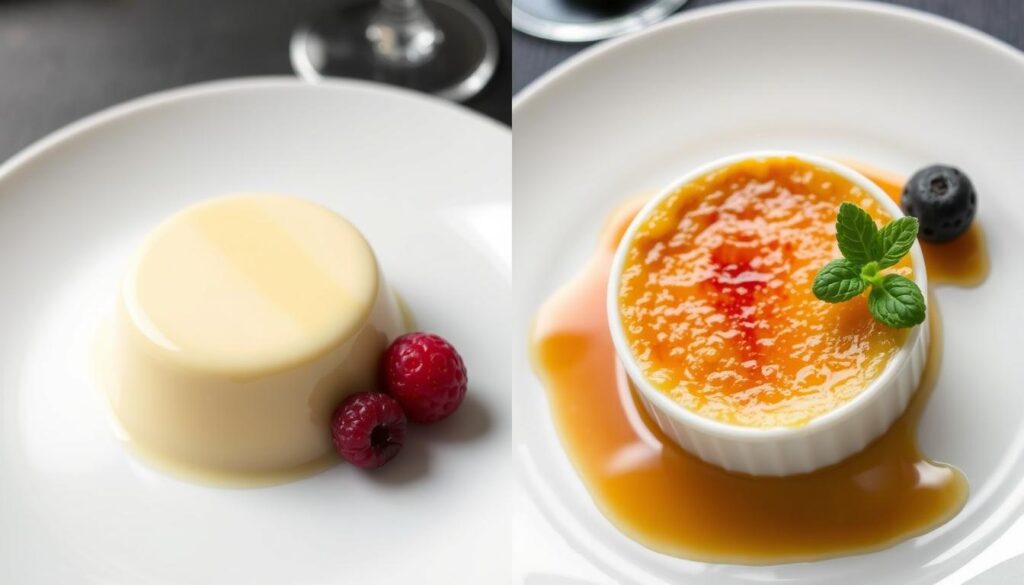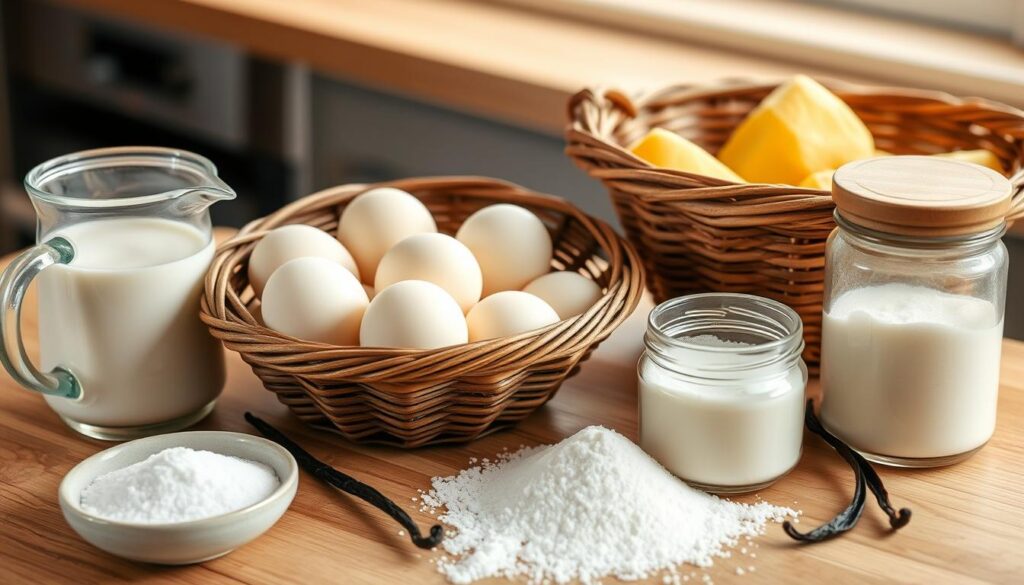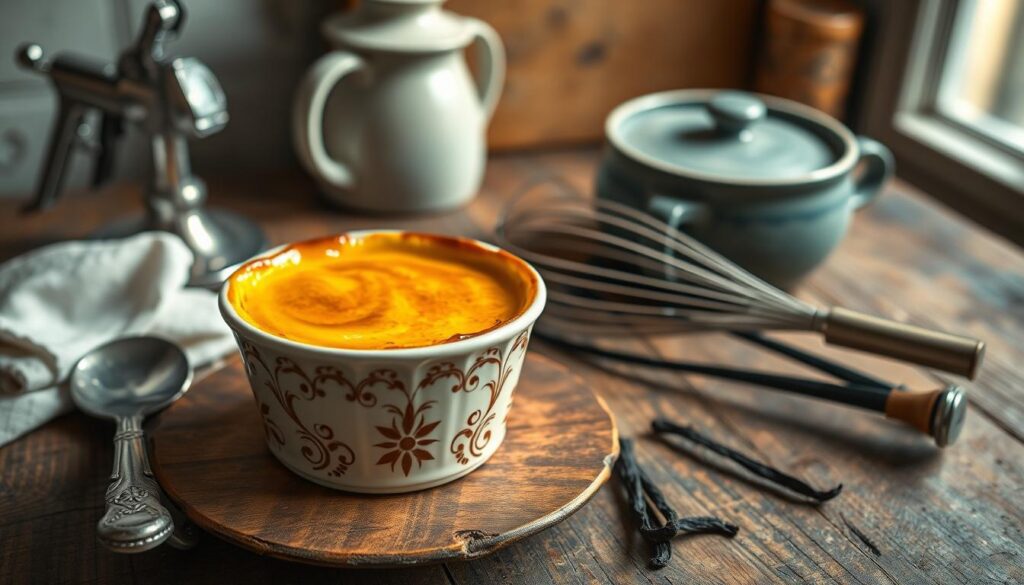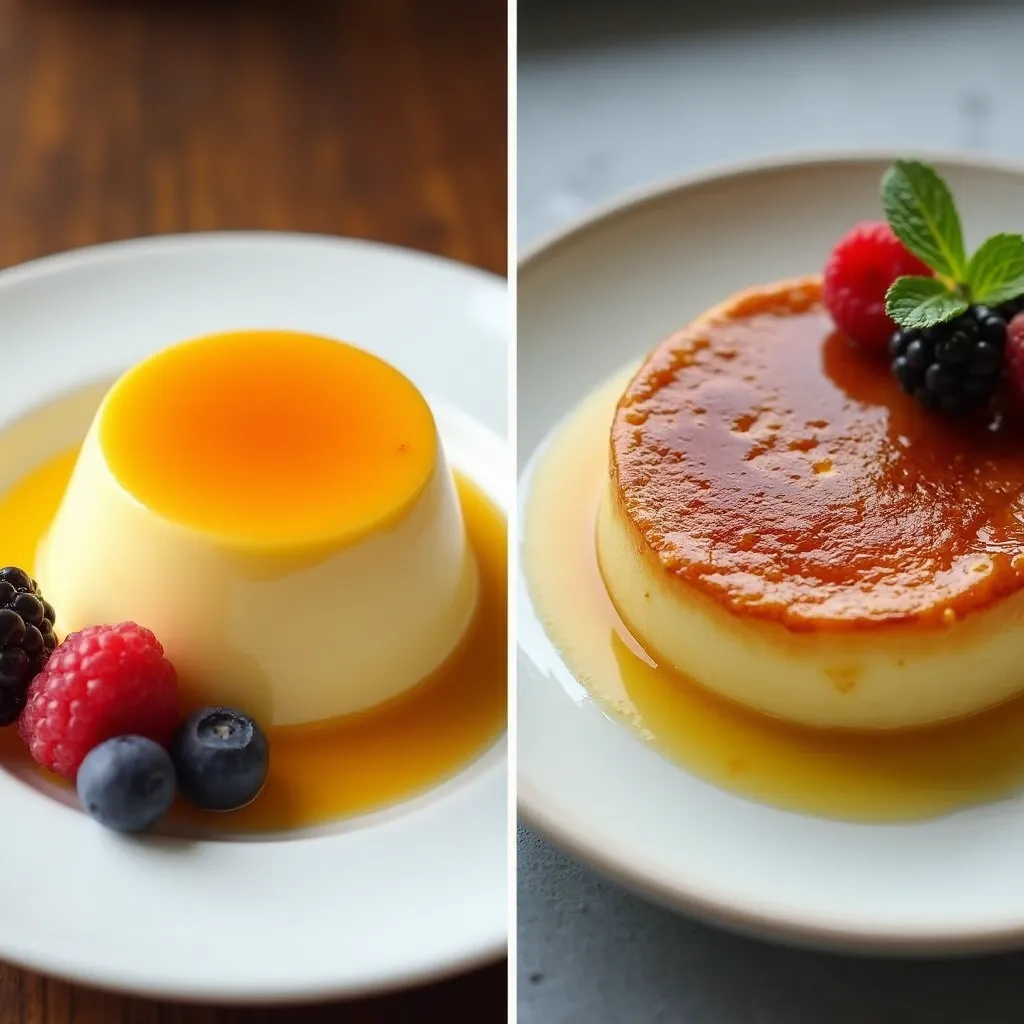When you enjoy desserts, you might wonder about the differences between crème brûlée and custard. Both are custard-based, but they have unique qualities. They differ in how they’re made and what they taste like.
Crème brûlée and custard share some ingredients, but they’re not the same. This article will help you understand these desserts better. We’ll clear up any confusion and explore their history and making techniques.

Key Takeaways
- Crème brûlée has a hard caramelized sugar crust, while custard is smooth.
- The ingredients and cooking methods greatly affect their texture and taste.
- Crème brûlée can be stored in the fridge for 2-3 days, making it great for ahead-of-time desserts.
- There are many crème brûlée flavors, like chocolate and pumpkin, to try.
- Both crème brûlée and custard are great starting points for exploring more desserts.
Understanding Custard: The Foundation of Many Desserts
Custard is a key ingredient in many desserts. It’s known for its creamy texture. It’s made from egg yolks, milk, and sugar.
This mix is vital in many recipes. It helps make sweets rich and tasty.
What is Custard Made Of?
The main ingredients of custard are:
- Egg Yolks
- Milk or Cream
- Sugar
The amount of each ingredient can change. For example, using only egg yolks makes a thicker custard. Adding whole eggs makes it lighter.
The type of dairy used also matters. It affects the custard’s richness and creaminess.
Types of Custards
There are different types of custards. Each has its own special qualities. Here are a few:
- Stirred Custard: Great for sauces or fillings, it’s creamy and cooked slowly.
- Baked Custard: Perfect for puddings, it’s cooked gently in a water bath.
- Pastry Cream: Thicker and used in cakes and tarts, it has cornstarch for stability.
Custard’s Role in Dessert Making
Custard is a vital part of desserts. It adds flavor and texture. It’s used in crème brûlée, flan, and custard tarts.
Learning about custards is key for bakers and chefs. It helps them make better desserts.

What is Crème Brûlée?
Crème brûlée is a rich dessert that has been loved for centuries. It comes from the Palace of Versailles, adding a touch of elegance. Known as “burnt cream,” it has a creamy base topped with a crunchy caramel layer.
Origin and Definition
France is where crème brûlée first appeared, becoming a key part of French cuisine. It’s loved for its history and simple yet rich taste. It’s often served in small ramekins, enjoyed worldwide.
Ingredients of Crème Brûlée
- 2 cups of heavy cream
- 6 large egg yolks
- 3/4 cup of sugar (1/4 cup reserved for caramelization)
- 1 teaspoon of vanilla extract
This mix makes a smooth custard, the heart of a great crème brûlée recipe.
Preparation Techniques for Crème Brûlée
Getting the preparation right is key to a perfect crème brûlée. Here’s how to do it:
- Preheat your oven to 325°F (163°C).
- In a saucepan, heat the heavy cream until it just begins to simmer. Remove from heat and add vanilla extract.
- In a bowl, whisk together the egg yolks and sugar until pale. Slowly pour the warm cream into the yolk mixture, blending thoroughly.
- Strain the mixture to remove any lumps and pour into ramekins.
- Bake in a water bath for about 20-25 minutes, or until set but still slightly jiggly in the center.
- Cool, then refrigerate for several hours.
- Before serving, sprinkle sugar on top and caramelize with a torch for that signature crispy layer.
These preparation techniques make sure your crème brûlée is both tasty and visually stunning.

Key Differences Between Crème Brûlée and Other Custards
Crème brûlée and other custards have unique textures and flavors. Knowing these differences helps us appreciate each dessert more. Crème brûlée is especially loved for its special qualities.
Texture and Taste Differences
Crème brûlée has a rich, creamy texture that’s different from crème caramel. Crème caramel is silky and served cold. But crème brûlée is creamy and topped with crunchy sugar.
This mix of smooth and crunchy creates a memorable taste experience. The caramelized sugar adds a sweet flavor to the classic vanilla taste of crème brûlée. Traditional custards, on the other hand, can have many flavors. They offer a wide range of tastes, unlike crème brûlée’s focus on a single sweet experience.
Caramelization Process Explained
The caramel topping is key to crème brûlée’s charm. It’s made by caramelizing sugar with a blowtorch or broiler. This step adds flavor and a unique texture to each bite.
Unlike basic custard, crème brûlée’s caramel topping makes it stand out. It shows off the skill of the chef, making it a special dish.
Crème Caramel vs. Crème Brûlée: More Than Just Names
Exploring custard-based desserts, we find big differences between crème caramel and crème brûlée. They have unique ways of making, tasting, and looking. Both desserts have their own special qualities, even though they start with custard.
Comparative Analysis of Both Desserts
Crème caramel has a soft custard on top of a caramel sauce. Both desserts are baked, but they’re made differently. Crème brûlée has a hard caramel layer on top, served in ramekins.
This difference in making gives each dessert its own feel and look.
Flavor Profiles and Serving Methods
In flavor analysis, crème brûlée is rich, thanks to heavy cream and vanilla. Crème caramel, on the other hand, is lighter, with milk and whole eggs. The way they’re served also shows their differences.
Crème brûlée is fancy, served in ramekins. Crème caramel is flipped onto plates, showing off its caramel sauce.
Crafting the Perfect Crème Brûlée
Making a perfect crème brûlée might seem hard, but it’s achievable with the right tools and knowledge. This guide will help beginners master this classic dessert. It covers essential tools, ingredients, and a step-by-step guide.
Essential Tools and Ingredients
To begin making crème brûlée, you’ll need these crème brûlée tools:
- Ramekins
- Kitchen torch (or broiler for an alternative method)
- Mixing bowls
- Whisk
- Fine mesh sieve
- Measuring cups and spoons
Here’s what you’ll need for ingredients:
- 1 1/2 cups (357g) of heavy cream
- 3 large egg yolks
- 3/4 cup (126g) of fresh crab meat (optional for variations)
- Vanilla bean or extract for flavor
- Sugar for caramelization
Step-by-Step Guide for Beginners
This crème brûlée cooking guide offers a clear path:
- Initial Preparation: Spend 15 minutes preheating your oven to 325°F (163°C) and getting your ramekins ready.
- Custard Base Creation: In a saucepan, mix heavy cream and vanilla bean seeds. Heat for 20 minutes until warm.
- Tempering Process: In another bowl, whisk egg yolks and slowly add the warm cream. Do this in 10 minutes.
- Assembly: Pour the mixture into ramekins and place them in a water bath for 15 minutes.
- Baking Process: Bake for about 35-40 minutes, checking for a slight jiggle in the center.
- Cooling and Setting: Let the custards cool for at least 4 hours for setting.
- Caramelization: Just before serving, sprinkle sugar on top and use a kitchen torch for 5 minutes.
For a special touch, garnish with fresh herbs or edible flowers. Enjoy with a glass of White Burgundy or Champagne for a better experience.
Creative Twists: Exploring Variations of Crème Brûlée
Crème brûlée is a canvas for culinary creativity. You can try different flavors and textures to make it your own. From classic vanilla to bold new mixes, you can tailor it to any event.
Flavored Crème Brûlée Options
Flavored crème brûlée opens up new possibilities in the kitchen. Here are some favorites:
- Chocolate – Rich and indulgent, chocolate crème brûlée satisfies any chocolate craving.
- Citrus – Infuse bright flavors with lemon or orange zest for a refreshing twist.
- Lavender – A hint of lavender offers a floral note, perfect for springtime desserts.
- Spices – Add a touch of cinnamon or cardamom for a warming finish.
Regional Variations and Their Unique Characteristics
Exploring regional dessert variations of crème brûlée shows global influences. Each culture brings its own twist, making it unique. For instance, French crème brûlée might have caramelized oranges, while Thai versions use coconut milk and pandan.
This flexibility lets you experiment with new ingredients and techniques. As you try different regional versions, you’ll see how they reflect local tastes. So, get creative in the kitchen and discover your next crème brûlée masterpiece!
Crab Brulee Recipe: A Delectable Twist on Tradition
Try this crab brulee recipe for a new take on a classic dessert. It turns a traditional dish into a savory baked crab delight. This creamy crab custard will impress your guests and make your meal special. Just follow the easy steps and use the ingredients listed below to make a unique dish.
Ingredients Needed for Crab Brulee
- 1 cup fresh lump crab meat
- 1 cup heavy cream
- 1/2 cup half-and-half
- 4 large egg yolks
- 1/4 cup grated Parmesan cheese
- 1 teaspoon Dijon mustard
- 1/2 teaspoon salt
- 1/4 teaspoon black pepper
- 1 tablespoon lemon juice
- Sugar for topping
Step-by-Step Cooking Instructions
- Preheat your oven to 325°F (160°C).
- In a mixing bowl, whisk together the egg yolks, heavy cream, half-and-half, Dijon mustard, salt, black pepper, and lemon juice until combined.
- Gently fold in the lump crab meat and grated Parmesan cheese into the custard mixture.
- Pour the mixture evenly into four ramekins.
- Place the ramekins in a baking dish and fill the dish with hot water until it reaches halfway up the sides of the ramekins.
- Bake in the preheated oven for about 30 minutes or until the custard is set but still slightly jiggly in the center.
- Remove the ramekins from the baking dish and let them cool to room temperature. Chill them in the refrigerator for at least 1 hour.
- Before serving, sprinkle a thin layer of sugar on top of each custard, then use a kitchen torch to caramelize the sugar until golden and crispy.
- Serve immediately and enjoy your creamy crab custard!
Conclusion
In our journey through desserts, we explored custards and crème brûlée. We learned about their unique qualities and how to make them. Custards are a base for many desserts, while crème brûlée is known for its creamy texture and caramelized sugar.
Crab brulee is a creative twist on traditional recipes. It combines crab meat with creamy custard. This dish shows how you can mix different flavors and textures in your desserts.
Trying out crème brûlée and its variations can make you a better dessert maker. Whether you stick to the classic recipe or try new ideas like crab brulee, your kitchen is a place for creativity. So, start baking and see what delicious surprises you can find in the world of desserts.
FAQ
What are the primary ingredients in custard?
Custard is made from egg yolks, milk (or cream), and sugar. These ingredients mix to create a creamy base for many desserts.
How do you prepare crème brûlée?
To make crème brûlée, mix heavy cream, sugar, and egg yolks. Bake it in a water bath until it sets. After cooling, a layer of sugar is caramelized on top, creating the iconic hard crust.
What distinguishes crème brûlée from crème caramel?
Crème brûlée has a hard caramel layer on top and is served in ramekins. Crème caramel has a soft caramel topping and is inverted before serving. These differences show in their textures and presentation.
Can I experiment with different flavors in crème brûlée?
Yes! You can add flavors like chocolate, lavender, or citrus to crème brûlée. This lets you make it your own.
What tools do I need to make crème brûlée at home?
You’ll need ramekins, a whisk, a mixing bowl, and a baking dish for the water bath. A kitchen torch is also key for caramelizing the sugar on top.
Is crab brulee a common dish?
Crab brulee is not as common as traditional crème brûlée. But it’s a creative twist with a creamy crab custard base. It’s a unique and flavorful dish.
How do I achieve the perfect caramelization for crème brûlée?
For perfect caramelization, sprinkle sugar evenly over the custard. Then, use a kitchen torch to melt and caramelize it until it’s golden-brown. Be careful not to burn it!
What types of custards are there aside from crème brûlée?
Other custards include pastry cream, crème caramel, and zabaglione. Each has its own texture and use in desserts.

